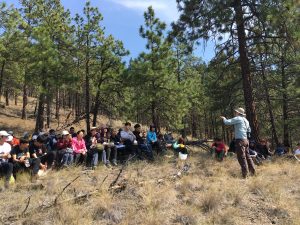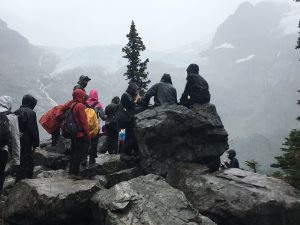I teach a field course that I absolutely love. Last fall, I was approached about trying to replicate part of this course in an online format. I thought that was a horrible idea. I said that moving a field course online negates absolutely all of the strengths of field instruction.
Eight months later, here we are. Given [waves hand around] all this, I have to answer the question: Can you move a field course online and teach it to students 8,000 km away?
I think the short answer is still no, but I’m going to give it my best shot anyway.
At the end of August for the past three years, I’ve taught an eight-day forestry field course to ~40 students (80 students the first year; that was rough). I love this course so much. It is a version of a long-running UBC Forestry field course, colloquially known as ‘Fall Camp’. My version of this course has a twist though. All of my students are new arrivals in the UBC Faculty of Forestry’s 3+2 program. These are students who start their education at one of our partner universities in China, study there for three years, transfer to UBC as third-year students, take two years of classes here, and graduate with a UBC Forestry degree. For the 3+2 students studying forest management, forest science, or conservation, my field course is the first course they take upon arrival at UBC. Many have only been in Canada for a few weeks at that point.
Most of these students have spent little or no time working or studying in the field, so it is a tremendous joy to introduce them to the forests of BC. We spend most of our time in the remarkable coastal rainforest, but we also venture to the Interior to see dry forests (I make sure to point out a prickly-pear cactus amid the ponderosa pines), and we hike to a high-elevation glacial lake so students can observe subalpine forests and the change in vegetation over an elevational gradient.
I really care about our 3+2 students. It takes tremendous bravery to move to a foreign country midway through a university degree to learn in a foreign language and in a very different cultural context. I know that I can’t replicate my field course through a laptop or iPhone. But regardless of what I do or don’t do, when the fall semester begins, these students will be taking their courses online with (non-transfer) classmates who’ve spent quite a bit of time in BC forests. Though I can’t take our 3+2 students into a forest, I think it is only fair to them that I do everything I can to prepare them for the fall. I’ve decided I’ll attempt to recreate parts of this field course in a digital format.
One of the ways I become a better teacher is by writing about teaching. It forces me to reflect, evaluate, and clarify my beliefs and practice. So I’ve decided to blog this process over the next two months as I prepare and deliver this online field course. Hopefully I’ll discover some insights along the way that will be worth your time.


